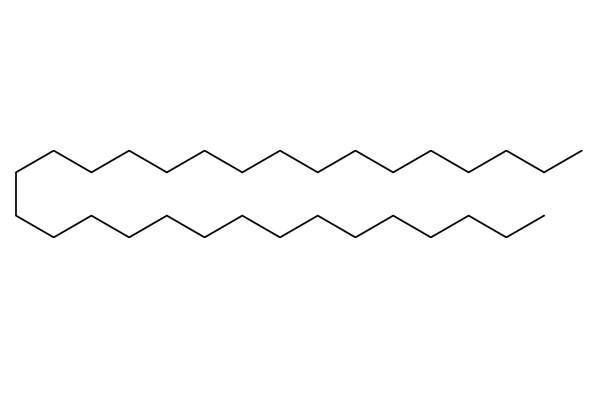Cas No: 8002-74-2
EINESC No: 100.029.375
Molecular weight≈ 785 g/moL
Chemical Formula: CnH2n+2
Chemical Structure:
Physical Properties
General Properties : Pale colorless solid
Odor: Odorless
Intensity: 0.9 g/cm3
Boiling point: 370 °C
Melting point: 37 °C
Flash point: 200 – 240 ° C
Vapor Pressure:
Solubility ( aqueous) indissoluble Refracture index :

General Properties
Solid paraffin, also known as petroleum wax, is a saturated hydrocarbona that usually contains 20 to 40 carbon atoms. It is usually acquired from fosil fuels such as oil and coal. It is a colorless soft solid. It is water insoluble but it dissolves in certain hydrocarbons such as ether, benzene and some esters. Although it burns easily, it is not affected by common chemical reactives. Therefore, it does not go through much digestion and it passes through body without disintigration. (this topic is stil debatable)
Paraffin has been used in many different fields since its discovery in 1830. Firstly it was used as candle due to its high heat capacity, combustion energy and proper melting point. It had caused many explosions in early 20th century.
Production
There are two methods for acquiring paraffin. Normally, it is a byproduct of oil. After acquisition, it is heated and frozen to make it remove from its fat. Purification might be necessary.
It can also be acquired from reaction of carbon dioxide and H2 gas, in presence of a catalyst and coal. This is called synthetic paraffin.
Applications
Paraffin is mostly used for candle production, even in today’s chemistry but it also has many different uses in different fields. It is used as lubricant oil for bicycle and motorcycle chains. In some textile productions, thread is covered with paraffin.
When paraffin is used to coat something, it gains a luminous, vivid appearance and blocks its contact with air. Therefore, many sugar candy’s luminous appearence comes from paraffin. Inks and satin papers contain paraffin. It is used as moisture blocker for electronics.
Many cosmetic products also contain paraffin. It softens the skin by preventing water from removing from skin.
It is used for sound insulators and thermostats in low doses. It is also used in book and radiation blocker productions.
Safety Measures and Toxic Values
Paraffin’s fumes are toxic for humans. Even medium exposure may cause head ache and nausea. It may cause respiratory diseases in repeated exposures. If it is swallowed, it is removed from body without much digestion but experiments on animals indicate that there are cumulations. This topic is stil debatable.